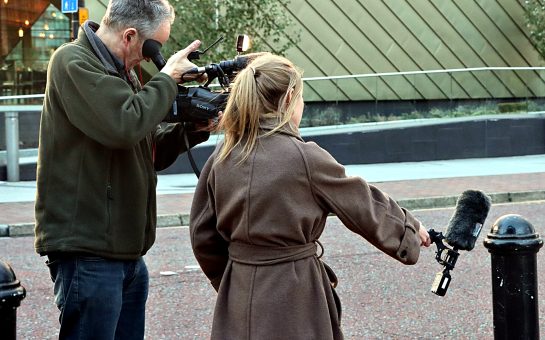Sally Rooney is the literary darling of the moment. For many, her novels, Conversations with Friends and Normal People, capture the voice of a generation, and have earned her a place in the millennial zeitgeist.
This set a high bar for BBC/Hulu’s co-production of the Booker long-listed Normal People. Would it conjure the melancholic loveliness of the novel, or butcher it for posterity?
Just a few seconds into the first episode, I knew that directors Lenny Abrahamson (Room) and Hettie Macdonald (Howards End) had managed it.
They had taken on the almost impossibly difficult task of adaptation, and they had won. Normal People is beautiful, moving, delicate, frustrating, tender and true, all at once. It is, dare I say it, the perfect adaptation.
The series charts the will-they-won’t-they love story of social outcast Marianne (Daisy Edgar-Jones) and sporting star Connell (Paul Mescal), as they move from the inane hierarchies of their school in small-town Sligo to the wider world of university.
Although tightly bound to each other by a powerful physical and intellectual chemistry, Marianne and Connell are somehow unable to talk about what they really want and feel. And as their expanding lives drag them in different directions, their miscommunications threaten to tear them apart.
While other coming-of-age romances might be viewed as hackneyed or trivial, Normal People cannot be so easily dismissed.
The series goes deeper than its boy-meets-girl premise, shining an unsettling light on the murkiness of its protagonists’ most private and vulnerable thoughts, on their brokenness.
There is a realness about it, a sense that this story is about us as well, about the parts of ourselves that we don’t share, not even with our friends.
The series also continues the novel’s exploration of the political, social and economic dimensions of love, staging a perceptive interrogation of the unwritten boundaries and rules which make and unmake our relationships.
As such, he emotional ebb and flow of Marianne and Connell’s love story is deftly intertwined with commentaries on wealth and gender, sexuality and status, the unseen forces which shape our most intimate moments.
Marianne is fiercely intelligent, sardonic and full of self-loathing, a collection of conflicting skeins that Edgar-Jones captures with grace and sensitivity.
Evolving from a delightfully awkward and unpopular schoolgirl to an edgily detached social butterfly over the 12 episodes, she inhabits Marianne’s strange combination of wisdom and naivety, revealing the sadness beneath her barbed façade.
At the outset, Connell would appear to be Marianne’s polar opposite. His sporting prowess, easy-going nature and good looks earn him an unconditional place in the popular group at school. However, he, like Marianne, faces his own inner demons.
Terrified of the opinion of others, he is embarrassed by his feelings for her, and would rather hurt her than reveal them. While Marianne blossoms at university, he flails, struggling to relate to the chino-clad, wine-quaffing, bluster-spouting students who are so different from his life at home.
Mescal plays this role with extraordinary emotional intelligence. While he effortlessly embodies Connell’s warmth and charisma, there are also moments where a spasm of panic seems to ripple over his body, in a widening of the eyes or a clenching of the fist.
Thanks to this attention to visual detail, he lays bare the anxieties roiling beneath Connell’s placid surface without any need for extraneous dialogue.
Around Marianne and Connell, other, vaguely recognisable characters flit in and out of the narrative, swirling around the central vortex of our two lovers.
Firstly, you have the “lads” at school, who shield their insecurities behind misogynistic “banter”. Then, at university, there’s Gareth (played perceptively by Sebastian de Souza), Marianne’s privileged but substance-less first-year boyfriend, whose inborn sense of entitlement allows him to ignore his mediocrity.
And then there’s her friend Peggy (India Mullen), who’s sexy and charming but also trying too hard to cultivate a sophisticated femme fatale persona.
These characters, who nudge the outlines of Marianne and Connell’s private moments, add depth to the series’ social commentary, as they reflect back at us people that we may already know.
Normal People was co-adapted by Alice Birch (who wrote the screenplay for the brilliantly sinister Lady Macbeth) and Sally Rooney herself.
The novel’s simple but plentiful dialogue and clear temporal breaks translate beautifully onto the screen, where Edgar-Jones and Mescal lend them a fresh sense of emotion and nuance.
The decision to split the series into 12 half-hour episodes also allows for an intensity of focus which avoids becoming gratuitous or overwhelming.
With six hours to play with, Birch and Rooney were able to linger over every conversation, every silence. Some of the scenes that are only alluded to in the novel are given several minutes of screen time, enhancing the story without completely overhauling it.
The production even succeeds in evoking the unique and unsettling intimacy of Rooney’s novel, which recounts sex scenes without euphemism or ellipsis, and delves, unflinching, into the darkest reaches of its protagonists’ minds, articulating the feelings they would prefer to leave unsaid.
Most conversations are filmed in head-shots, with the camera moving almost impossibly close to Marianne and Connell’s faces, allowing us to pore over the texture of their skin, the tiny shifts in their expressions. In one shot, our view of Marianne is partly obscured by the side of Connell’s head, as if we were looking at her through him.
Indeed, in some scenes, we can’t know whether we are seeing events as they really happened, or whether we are inhabiting a memory or an imagining. In this way, we seem to slip momentarily into the characters, as the images on screen subtly mirror the intimacy of Rooney’s narrative.
Many shots also have a haptic quality; as the camera sweeps over its characters and landscapes, it captures the strands of hair falling from Marianne’s bun, her fingers in sand, Connell’s pulse beating in his neck, or his hands gripping the steering wheel.
You’ve all been obsessed with the music in #NormalPeople, and rightly so. Here’s the full soundtrack courtesy of @bbcsounds.https://t.co/RBIP1CVoCl pic.twitter.com/98JljeRZw3
— Normal People (@NormalPeopleBBC) May 1, 2020
In these sensual moments, Abrahamson and Macdonald create the feeling that we might reach out and touch them, that we are inside their intimacy. It is this closeness that makes us really care about these young people, and recognise the profundity of their ostensibly mundane lives.
Rooney’s Normal People is the most complete love story I have ever read, but this adaptation somehow manages to make it better, as it lends colour, breath and life to Marianne and Connell’s endless search for themselves, and for each other.



